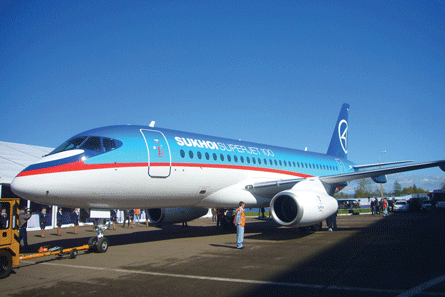The emergence of new regional jet manufacturers is giving regional carriers more choices than ever before. But can the manufacturers overcome resistance to acquiring aircraft from eastern sources?
Mesa Air Group chief executive Jonathan Ornstein likes to think of his airline as a pioneer. Mesa has just launched an innovative joint venture carrier in China, Kunpeng Airlines, and is looking at establishing similar ventures in Central America and the Middle East. But what may be most pioneering about Mesa is its evaluation of new regional jets.
In a major competition that could provide a glimpse into the future of the increasingly dynamic regional jet market, Mesa is evaluating the existing products from Bombardier and Embraer against new offerings from Russia's Sukhoi and China's AVIC 1 Commercial Aircraft Company (ACAC). The winning aircraft will form the backbone of Kunpeng's future fleet and will likely also be acquired by Mesa for its US operation. Ornstein says Bombardier is "the frontrunner" but ACAC's ARJ21-900 is also a serious contender for the 50 aircraft plus 50 options order: "It can be very advantageous to have a Chinese aircraft in China. If the government wants to make it work, they will put the resources behind it."
 |
|---|
| "It's not as much of a leap as some people think" Jonathan Ornstein, Chief executive, Mesa Air Group |
But ACAC must first convince Western carriers it can match the aftermarket support provided by Bombardier and Embraer, which have enjoyed a duopoly in the regional jet market since Fairchild Dornier collapsed in 2002. This is by far the biggest challenge for ACAC, Sukhoi and Japan's Mitsubishi. All three have large domestic markets but will need sales in the reluctant West for their new regional jet programmes (see chart) to survive.
"The Russian concept of product support historically has been light years away from the Western concept," says a European carrier vice-president who requested anonymity. "For a Chinese product the design, experience and structural as well as product support concerns would be a big mental challenge."
Adds the director of Philippine regional carrier Seair, Nick Gitsis: "Our concerns would start with JAR and FAA type certification and acceptance for those aircraft, although this is not an insurmountable issue. From there, issues with support would be an important consideration, because from our experience, support and customer service is very far from what we experience with Western suppliers. Coupled with the question of viability and longevity, the supplier would have to make a very convincing argument."
Ornstein acknowledges that product support along with aircraft financing are two major concerns, but he points out the ARJ21 is not entirely a Chinese aircraft: "It's made in China but it has GE engines and Western avionics. It's not as much as a leap as some people think because we're familiar with many of the suppliers." This is certainly a card all the manufacturers will be playing in their campaigns to Western carriers. "The story we're telling airlines is we have a French engine, German flight controls, French avionics and Italian in-flight entertainment systems and interiors. Why label this aircraft Russian?" asks Alessandro Franzoni, chief executive of new Alenia-Sukhoi joint venture Superjet International.
Air France is certainly aware of the Superjet's French content. It is one of about 15 carriers, including Brit Air and Lufthansa, planning to attend the next Superjet airline advisory meeting. "We'll certainly evaluate it," says Air France chief executive Jean-Cyril Spinetta. "[A decision to buy it] will depend on price, performance and customer support."
Adds Embraer chief executive Fred Curado: "I think the aircraft will be perceived as having western content. But the real frontier is the support infrastructure. It is a question of investment and competence but it is doable."
Alenia and Sukhoi have invested in Superjet International's new Venice facility to provide Western-style aftermarket support. "We want to face the customer community with a very Western approach to support," Franzoni says. "[Sukhoi] understands, although it's difficult to admit, that it doesn't have a great image in the Western world for certification and support. We partners are doing our best to make Superjet International not a Russian, not an Italian but an international company."
To similarly help woo Western customers, ACAC has enlisted the help of Bombardier, while Mitsubishi plans to work with Saab. Bombardier does not plan to enter into any joint ventures but has agreed to be a risk sharing partner in the ARJ21-900. "Our assistance will come in helping them develop a competitive organisation, making them more competitive than the Russians or Japanese, using Bombardier's past experience in the regional jet market," says Bombardier commercial aircraft programme director Benjamin Boehm.
Bombardier has already begun helping ACAC with the technical assessment definition phase of the ARJ21-900 programme. The two companies are working to boost the aircraft's competitiveness by addressing some of the design shortcomings of the -700, in particular its lack of composite materials, while maintaining commonality between the two models. But until the two companies convert the memorandum of understanding they signed in July into a definitive agreement, Bombardier will not start talking to potential customers and its role in supporting the aircraft in the West will remain undefined.

Saab's Aerotech division and Mitsubishi are also still working to convert an MoU into a definitive agreement. Saab intends to provide support in Europe and the USA but the Mitsubishi Regional Jet's (MRJ) launch customers, expected to be announced at the end of March, will most likely be Japanese.
So far only one Western carrier has agreed to buy any of the new regional jets, with ItAli Airlines ordering 10 Superjet 100s for delivery from late 2009. Franzoni is confident a second Western customer will be secured in 2008: "I know it's a tough target to sell an aircraft to a Western customer before certification. But the 787 has taught us a lesson that nothing is impossible."
ACAC is now working to convert into a firm order a letter of intent for two ARJ21-700s with its overseas launch customer, Lao Airlines. ACAC is not pushing the -700 in the West but is confident it can sell Western carriers the -900 and has begun discussing possible certification with the FAA. "We plan to establish a representative office in the USA and later a subsidiary in the USA to do marketing, sales and customer support," says ACAC president Luo Ronghuai.
Superjet International also plans to open an office in Washington although Franzoni says "certainly the US will need a little more time to be developed" compared to Europe. While Western carriers are reluctant to acquire Eastern aircraft, they are happy to have more than two options. "Taking into consideration that in the West there has been a severe consolidation of manufacturers over the past 30 years resulting in heavy backlog of orders and continual increase in pricing, we look forward to other options and possibilities in turboprops and regional jets such as these," says Gitsis.
Bombardier and Embraer are not concerned. Curado says the new products do not pose a short-term threat: "The Mitsubishi jet will not be competing with the existing E-190, it will be competing with the improved E-190. It is the same thing with the Russians and Chinese." Boehm adds: "We feel there is still enough market to go around."
Source: Airline Business























